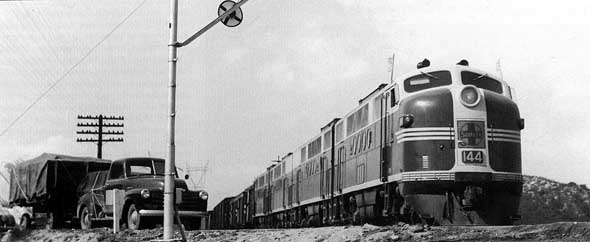| From the time they were built and into the early 1950's the freight FT's wore the familiar blue/yellow Santa Fe freight colors with a nose emblem known to railfans as the "catwhisker" design. This nose emblem featured a square Santa Fe herald on the nose door and three horizontal yellow stripes, "catwhiskers," extending from the herald around the nose to a point below the windshield. |
 In February 1951 an eastbound extra pulled by FT 144 passes the highway 138 grade crossing at Pine Lodge. Note the marker lamp at the left of the badge plate on the nose. Speculation is some units assigned in Cajon Pass helper service received this modification in 1950's thus eliminating the need for oil marker lamps at the rear end of the helpers. |
|
On early units, the nose herald was a separate bronze plate with the herald painted on in blue which was then bolted to the nose door. On later units, the herald appears to have a much lighter background (see the modeling notes for additional details). The as delivered paint scheme featured a red separating stripe between the blue and yellow colors. As units were repainted in company shops the red striping was at first maintained on the nose of A-units forward of the cab doors and was finally deleted completely, undoubtedly a cost saving measure. A-units carried the "Santa Fe" name on the carbody under the portholes and above the side number boards, but B-units did not carry the "Santa Fe" name. Members may examine their reprints of EMD's styling diagrams included with this issue for comprehensive painting and lettering instructions for the as-built locomotives (also for F-3's and F-7's). EMD donated aperture cards of these original blueprints to the Santa Fe Modelers Organization and their courtesy is greatly appreciated. In the early 1950's, at least in late 1951 and early 1952, the Santa Fe experimented with a simplified paint scheme for its F-units that featured a solid blue carbody with a passenger style nose emblem and a yellow nose stripe. A fair number of FT's were repainted in this manner, from single A-units assigned as road switchers to complete A-BB-A lashups. Fortunately, the Santa Fe decided against adopting this rather drab scheme and resumed painting its F-units in the full blue/yellow scheme although it did retain the passenger-style nose emblem and did away with the catwhisker emblem. Units that had received the simplified scheme were fairly quickly repainted with full yellow markings. Bunits received the "Santa Fe" name below the portholes as on the A-units. Over the years the Santa Fe added extra grab irons, wrecking lugs, and radio antennas the FT's which cluttered up their original smooth lines while giving them a distinctly Santa Fe appearance. By the mid-1950's the FT's were showing their age and the railroad began trading in some of the early high mileage units on new locomotives. 100LAB plus 180A (ex-lOOC) were the first to go, these units being traded in on four new GP-9's in February 1957. Early technology brake, throttle, and electrical systems made the FT's unattractive for a major rebuild, so their days were numbered. More would have been traded in on new GP-9's had a recession not delayed such a trade in at that time By 1960 EMD was offering attractive trade-in programs to replace four worn out FT's with three new GP-20's, then GP-30's and GP-35's, so the FT's were traded in large numbers, giving up their still-useful Blomberg trucks for use under the new locomotives. All of the Santa Fe's GP-20, 30 and 35's originally rode on traded-in FT trucks. The FT carbodies were cut up for scrap and not one Santa Fe FT survived scrapping. |







